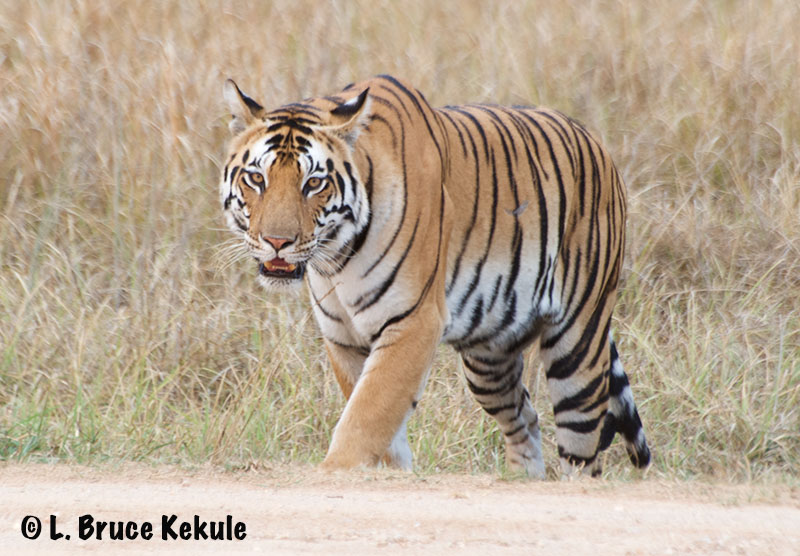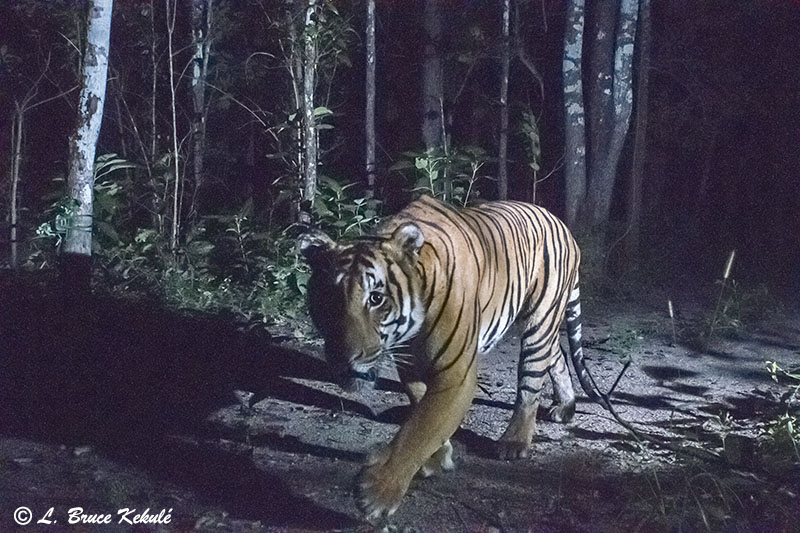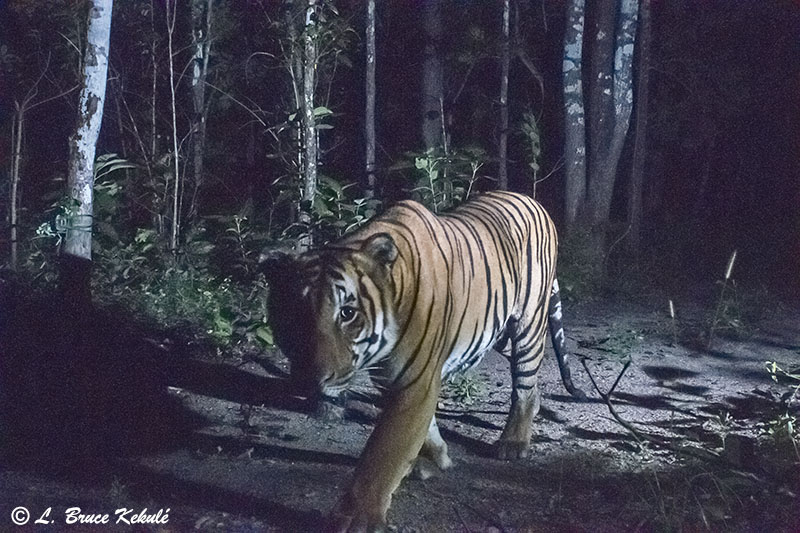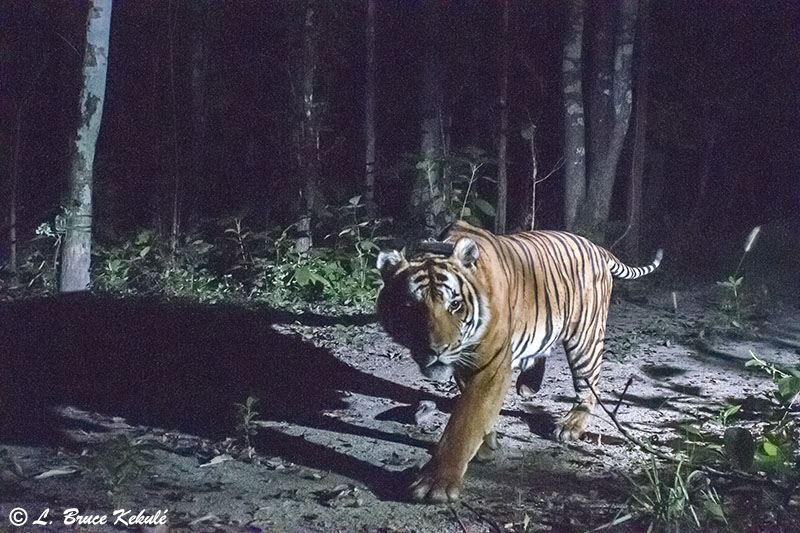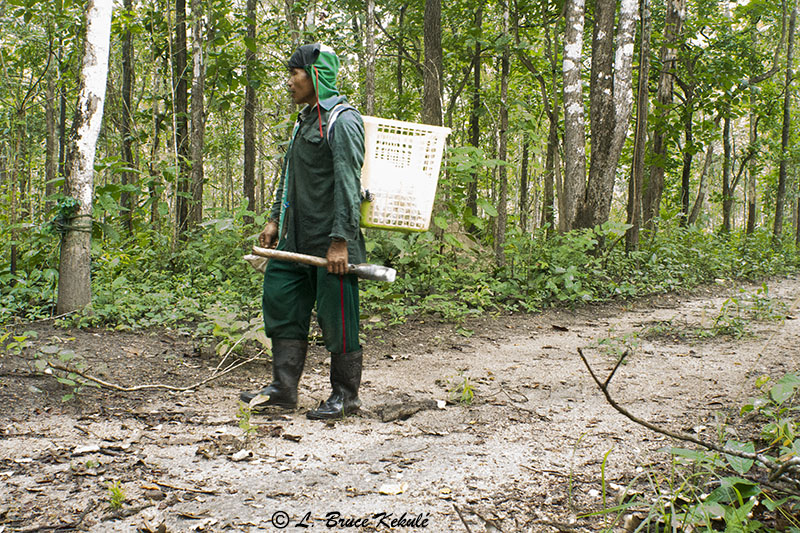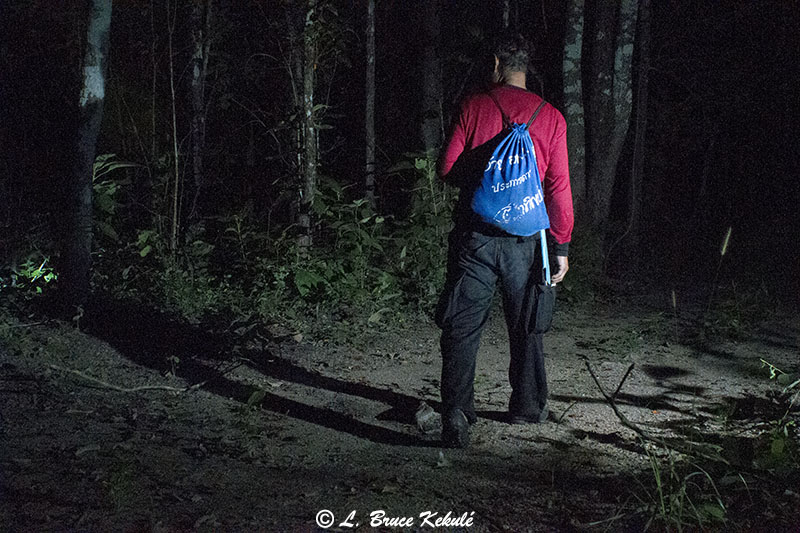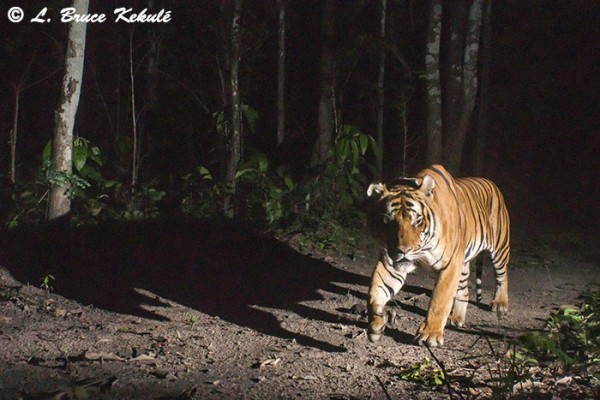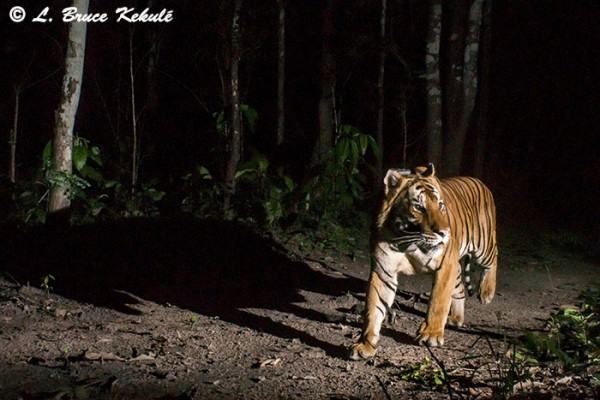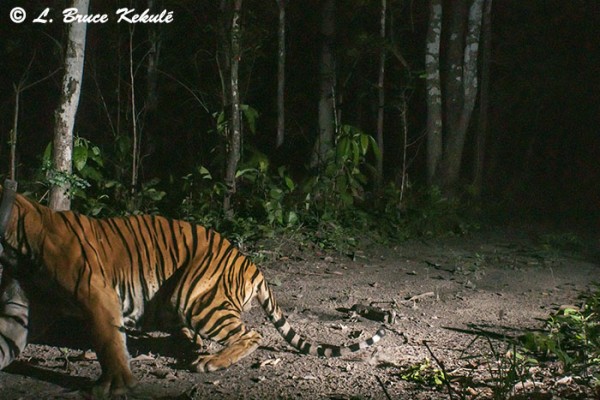Posts Tagged ‘wild cat’
Kanha National Park: The best run protected area in India
A tiger reserve in Madhya Pradesh
‘Jamun Tola Male’ or T-24 drinking at a small natural waterhole early in the morning…!
If someone ever has an urge to visit one of the best ‘tiger reserves/national parks’ in India, pick Kanha in the southeast of Madhya Pradesh State. The forest department is commended for improving the visitation to the park by both local and international tourists, and my hat is off to them for implementing some great new measures.
‘Naina Female’ or T-76 coming straight at us…!
They have made it a regulation that all forest guides be equipped with a GPS (actually a smart phone with a GPS App.) The authorities can now check the speed limit which is 20 kms per hour and is strictly enforced. If a jeep goes off track or goes too fast, a tough lesson will be learned by both the driver and the guide. It is now very well organized and they pay attention as some have already been red-carded for excessive speed and other infringements. That means anywhere from a seven to fifteen-day suspension, or even longer. The drivers/guides now pretty well toe the line which keeps the dust down, and is much safer and more enjoyable then previously…!
T-24 crossing the road…!
While I was there this past February, sightings were down a bit but the department is creating fire lines by burning fallen leaves on the side of the road that somehow effects tiger sightings. I experienced this same thing in Pench National Park last year where they were doing the same thing burning leaves but now I realized for a good reason. I did not really think about it at the time and did not get any tiger sightings, but did hear several tigers roaring in the dense forest. The big cat just moved away from the road temporally. March is when they expedite this safety program to keep forest fire down to a minimum.
T-76 in the late afternoon just before closing time..!
However, I did get two tigers this time shown here; a female known as T-76 or ‘Naina’ in the afternoon as we were heading back to the gate. We stopped at a T-junction for few minutes and she popped out of the grasslands in front of us for some really great head-on shots. Then the next morning as we were motoring around, we bumped into a bunch of jeeps parked along one side of the road. We slipped into a space and were there for 10 minutes when a male tiger was seen rustling in the bushes directly across from us. He then sauntered down to a natural spring and stayed at the waterhole for more than 10 minutes slurping up a needed drink. I kept on shooting until he moved and in a few minutes, he popped out on the road and as he crossed, I got some good flanking shots of ‘T-24’ known locally as the ’Jamun Tola Male’…I was elated to say the least…!
So, my recommendation is: if you want a great visit with the possibility of seeing a tiger, go to Kanha as it is well worth the trip. Again, well done Forest Department Director Dr Sanjay Kumar Shukla IFS Field Director Kanha Tiger Reserve and staff, and I look forward to future visits to India’s best run tiger reserve and national park. Every park in the country should now take note and follow suit, as most of the other ones continue to have serious problems with jeeps racing for position, and absolute mayhem when tigers are spotted. This will be tough to implement but given time, I’m hoping things will get better in the other tiger reserves scattered throughout India.
Nikon D700 catches an Indochinese tiger
A female tiger returns again…!
About five months ago, I set a Nikon D700 DSLR camera trap at a hot spring deep in the interior of the Western Forest Complex of Thailand. I managed to get some nice shots of a female Indochinese tiger as she walked back and forth, and up and down to the mineral seep. I then moved the D700 to another tree close by for a better capture and composition. When I got to my camera last week and checked my files on the Nikon, I almost fell off the log I was sitting on. There she was again but this time with expression, behavior, focus and exposure perfect. This shot is one of my best all time tiger camera trap images….great success at last at this new location…Enjoy…!
Camera: Nikon D700 full-frame body
Lens: Nikon 35mm manual lens (very old)
Sensor: Snap Shot Sniper SSII
Case: Pelican 1150
Box: Aluminum ‘elephant proof’ housings for camera, flashes and sensor
Flashes: Two Nikon SB-28s
Exposure: 1/200th – ƒ5.6 – ISO 400
The first shot in the string…!
An Indochinese tiger caught by a Canon 600D: my favorite tiger image..!
After a few years of DSLR camera trapping in the Western Forest Complex of Thailand, I have finally chosen an image of a male Indochinese tiger caught one afternoon at 4.41pm that is my all-time favorite. For this location, I built a Canon 600D with an old Nikon 50mm manual lens incorporating an adapter (Nikon to Canon) in a Pelican 1150 case with an external Snapshotsniper SS II sensor on a 10-meter hardwire, and two SB28s in Tupperware® style boxes also on 10-meter hardwires. This mature tiger was out hunting when he passed the cam and the manual settings were ISO 400; ƒ8; 1/100 sec. and this shot was the last in a string of six. Enjoy…!
Male leopard crosses ‘tiger log’…!
Last month, I had a hamburger at a joint close to my house up-north in Thailand. The next day, I was admitted to hospital with a ‘acute’ food poisoning. It has taken almost a month to get back to normal, hence not much camera trap work from my end. However, I finally got to my only Nikon D700 DSLR trail camera and got a pleasant surprise.
A male leopard (can just see his family jewels) crossing my ‘tiger log’…this is in the ‘Western Forest Complex’ of Thailand…! Daytime shots of leopard are rare for the most part but it does happen here where I work from time to time…Enjoy…!
Camera settings: 1/160 sec; f/8; ISO 400
Nikon D700 – Nikon 35mm manual lens – Two Nikon SB-28 flashes – SSII external sensor
The Asian Leopard – Thailand’s 2nd largest wild cat…!
This film is a culmination of videos and still photographs of leopards captured by video and DSLR camera traps in the ‘Western Forest Complex’ of Thailand. The first black cat video was taken just a few months ago. Enjoy..!
An ISO Blunder
Sony A500 catches a tiger and poachers at ISO 12,800
Sometimes, mind lapse is a serious problem for a senior citizen like myself. I set my Sony A500 on a trail just inside the boundary of my favorite protected area in Thailand. This location has already produced some amazing shots of black leopard and tiger plus many prey species like elephant, banteng, barking deer, sambar and wild pig.
Tiger passes the Sony A500…!
Tiger with a radio collar passes the Sony…!
On the negative side of things, this cam has also caught poachers and gatherers as they illegally sneak into, and exit the sanctuary. Poor patrolling and enforcement with many loopholes allow these undesirables to penetrate and poach animals and forest products for sale or personal use. It is a serious threat to all of Thailand’s protected areas and is on-going problem for the Department of National Parks (DNP)…!
Poachers with baskets and digging tools after bamboo shoots during the rainy season…!
Wildlife poachers with no basket…!
This Sony has been working very well catching a male tiger with a radio collar at night several months ago. I noticed that several people on the forum were setting their cams at ISO 200 and thought I would give it a try. When I left the cam, I thought it was at the 200 setting.
A month or so later, I went back to change out batteries, card and desiccant, and saw the same tiger with a collar had visited twice plus some poachers caught using the same path. When I downloaded the images, I was shocked to see the ISO at 12,800…what the heck happened here…?
I don’t know but it looks like I did not save the settings before buttoning up the cam and somehow pushed the 12,800-button. This was of course another disappointment. The shots are cluttered with noise and I have tweaked the images but it’s a fact: photos with ISO this high is absolute rubbish and can only be counted as record shots.
Another thing: only one flash on the right was working hence the deep shadow. I found a broken wire on the other flash so brought the whole unit in for repair. I will be setting another Sony (A55 with a 55mm lens) DSLR cam with 4 flashes (hard-wired) to see what might pass-by.
The ‘Tiger Hunter’ setting a Bushnell Trophy Cam…!
The A500 cam is now back in the forest but at a new location with settings at ƒ8 – 1/125 – ISO 200. It was working well firing off 4-shot strings during walk test and hopefully it will produce some good shots now. Leopards and tiger plus all the other denizens of the Thai forest use this trail so I can only wait till I get back to the cam in a couple weeks.……!
Nikon D90 catches a rare ‘clouded leopard’…!
One of the most beautiful of all the Asian wild cats
Once upon a time, the clouded leopard (Neofelis nebulosa) was found all over Thailand when some 75 percent of the country was covered in forest. At the end of WWII, the human population really began to explode and these magnificent biospheres were cut down for agriculture and settlement taking all the natural resources in its wake. Modern transportation, weapons and logging on a grand scale began to quickly shrink this once remarkable heritage.
Barely 20 percent forest cover is now surviving in an ever-shrinking wilderness. The clouded leopard has been exterminated primarily for its pelt and now survives in all but a few protected areas throughout the Kingdom. It is one of the most beautiful marked creatures in the world. The marbled cat (Pardofelis marmorata), another wild feline is similar in coat pattern but smaller in size. Both of these cats have become extremely rare throughout their range.
In July of this year, I decided to make a trip down to Khlong Saeng Wildlife Sanctuary in southern Thailand in conjunction with Greg McCann and Habitat I.D. (NGO to monitor wildlife in Southeast Asia) to set some camera traps in the moist evergreen forest to see what was still thriving here. Three years ago, I did a camera trap and photographic survey of this protected area and got a marbled cat up on a ridgeline in the interior, plus a clouded leopard in a cave entrance at another location. I knew there was still good possibilities that I would get these cats again.
I decided to set my Nikon D90 DSLR trail cam along with a couple Bushnell Trophy Cams at this same location. Unfortunately, the hard-wired slave flashes were not working due to wiring problems and so left the cam with its single hot-shoe mounted Nikon SB-400 flash. I knew then if the cam caught any creature, I would get images with ‘eye-shine’ but decided to leave it anyway.
I have just returned from Khlong Saeng to collect the data from these cams. Imagine my surprise to see a clouded leopard on the D90’s card. It was an absolute joy to see this cat had passed the cam and even though the ‘eye-shine’ was there, the markings and beauty of this carnivore is truly remarkable. I have pulled the D90 and put a Canon 400D with three Nikon SB-28 slaves which was working very well when I left it. The Bushnell cams also recorded many other species and I will be doing a video post soon. Enjoy…!
Indochinese tiger male caught on video and DSLR
A video and still photos of an Indochinese tiger in the Western Forest Complex of Thailand. This male cat was camera trapped in the afternoon and then in mid-morning…a beautiful carnivore.
The message is the same: these magnificent cats need 100% increase in protection and enforcement as they have become extremely rare in the wild. Unfortunately, some bad people chase after them for bones to be sold on the black market…! The main worry is that help will come too little and too late to really save the tiger and other creatures of the Thai forest…! Enjoy the beauty of raw nature but never forget this message: We need to work hard to change things so these magnificent cats will continue to roam the forest…!
Canon 600D catches a big male tiger
A lucky catch in late afternoon…!
I was finally able to set my Canon 600D with two Nikon SB-28 flashes on a trail where I previously set my BFOutdoors P41 and captured tiger, yellow and black phase leopards plus many other creatures found in this forest. It has been a great location and the set has been very productive.
However, the sensor was not working properly (old #5 with refresh) and run the batteries down. I recently got the #5 program without refresh (many thanks to Johnnydeerhunter on Camtrapper.com) and installed the new chip. It worked like a charm and the Canon will fire off 6 shots a second and wake-up the flashes. The cam and flashes were working great when I left it. I also set up a DXG 567 ‘blackflash’ homebrew video cam close to the Canon to record any animals that passed by (I’ll be posting a video of this cat passing the cam twice).
It has been extremely wet and for some odd reason, the flashes stopped working but the camera continued to crank along. I was pleasantly surprised when I visited the location a couple days ago. On the card was a male tiger that walked past the cam at 4:40PM on October 4th but the flashes did not trigger which created some undesirable noise in this image. This shot is the best of the lot with some highlights on his family jewels and legs, plus a superb back-lit forest. Needless to say, I was still happy with the results and will put this Canon back ASAP…the location certainly has potential and my hope for that black leopard continues…one of these days….Enjoy…!
Sony A500 catches a male tiger with a ‘radio collar’
A male Indochinese tiger in the Western Forest Complex of Thailand..!
What are the odds that my DSLRs would capture two different tigers sporting radio collars within one week of each other..? These are real fluke camera trap shots taken some twenty kilometers away from my Nikon D700 that caught a female also with a collar at the ‘tiger log’. I just posted this on this website a couple of days ago. http://brucekekule.com/camera_trapping/nikon-d700-catches-an-indochinese-female-tiger-sporting-a-radio-collar/
The Sony A500 was triggered by a male tiger on Sept. 17, 2014 at 10:26 PM while the D700 got a female on Sept. 24 at 5:45 AM. I only captured two tigers this trip and it seems weird that they both have collars. Maybe the ‘spirits of the forest’ wanted me to really show and tell the world what is actually going on in this forest concerning tigers. Who knows..?
Needless to say, I’ve already vented my feelings about tigers and radio collars in my recent D700 post so there’s no sense in going there again. However, the A500 got a nice string of shots of this male with a huge collar. I think the battery is on the bottom and transmitter on top. This monstrosity surely looks heavy..!
Unfortunately, only one flash on the right triggered which was a bit of a let-down. The other flash was up high on the tree pointing down at the tiger and would have cancelled that shadow. It was one of those things and there’s always next time. The A500 fired four quick shots and as the big cat jumped forward, triggered another five as he leaped to the right. All in all, I was still pleased with the results and look forward to a ‘black cat’ that I once videoed in broad daylight at this very location.
Noise is also a problem with these images, as I had to do some heavy tweaking in Camera Raw and Photoshop to get them to acceptable levels. If I had been shooting in JPG. format, there would be no chance to bring these back. RAW capture is the only way to revive images when things get dark with not enough light.
I’m not sure if this is inherent to Sony but I think most makes and brands with low light means serious noise although the newer pro-cameras handle noise quite well. The settings are: ƒ8 – 1/80th – 400 ISO…flash set to ¼ power, and lens was a Minolta 28mm (old lens I have had for years). It’s a wonder I got these shots at all..!
Oh well, back to the drawing board on flash standby power. I’m putting together a couple Nikon SB-28 and SB-600 flashes that will work with hard-wire or radio triggers with four Eneloop AAs in the flash and four rechargeable ‘Ultracell ‘D’ cells with 11,000 mAh capacity as externals to add more power for longer soaks. This will all fit in a lockable ‘Tupperware’ type box as shown.
I will try these on the A500 first to see if there is a difference with staying power. I also believe that three or more flashes are the ticket for well-lit shots…I know Steve Winter with N.G. sometimes uses from 4-5 flashes depending on terrain.
It’s a never-ending battle with the DSLRs but I guess that’s what I like about using them: the challenge to get tigers and leopards on digital camera plus all the other cryptic animals in Thailand’s forests…it all becomes worthwhile when I do get a shot or shots…! Enjoy.





